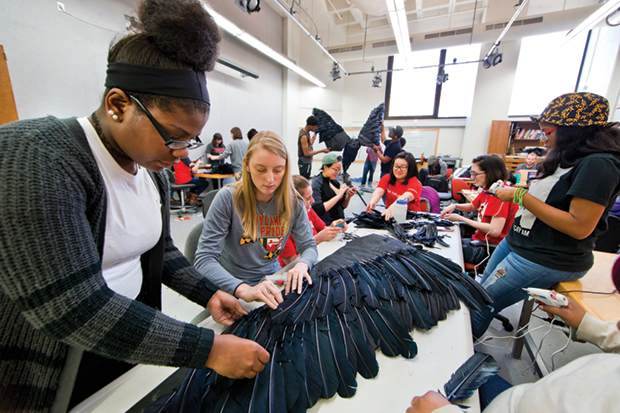UMD graphic design students met with high schoolers from the Augusta Fells Savage Institute of Visual Arts every two weeks in a UMD studio to work on pieces for the exhibit.
UMD, Baltimore High School Students Explore Race and Urban Unrest Through Art
by Natalie Koltun ’16 | photo by John T. ConsoliThe vulture hunches menacingly over the room. Its outstretched wings, shaped by long black feathers and metal wiring, span more than five feet. Fixed atop its head is a security camera.
Its prey is the black youth of Baltimore, as this scavenger is a piece of art crafted by students to express their feelings about the police presence in the city, particularly during last spring’s unrest.
The vulture is just one part of a contemporary art exhibit by advanced graphic design students from the University of Maryland and high schoolers from the city’s Augusta Fells Savage Institute of Visual Arts.
“Youths have unique stories to articulate, but their message resonates with people of all generations,” says Audra Buck-Coleman, assistant professor of design. “Art can reach people in unexpected ways.”
She launched the project after watching media coverage of riots that followed Freddie Gray’s death. She says news outlets’ accounts focused almost exclusively on violence and destruction, which generalized the city’s youth population as criminals.
Producing the "BMORE Than the Story" exhibit, running through Aug. 28 at the Reginald F. Lewis Museum in Baltimore, gave the 25 Augusta Fells students an opportunity, she says, to “reclaim their narratives” by sharing their stories surrounding the city’s turmoil.
Catania Nolan, a junior at Augusta Fells, helped create posters that show only quotes from city officials and news articles until placed under a black light. Then changes to the quotes appear, reflecting the students’ perspective.
“Our story is more than just what was in those news stories,” Nolan says. “Yet a lot of people think us kids don’t really understand what happened. But we were there. We saw it, lived it and went to school right in the middle of all of it.”
Other components of the exhibit include a wall of 1,300 names of those who, based on the students’ research of newspapers, crime reports and databases, died from police brutality in the city since 1960; a chalkboard asking, “Who are you? And who are you not?” to spark conversation among museum visitors; and videos of students dancing, rapping and sharing poetry about their experiences.
Genesis Henriquez ’16, creative director for UMD’s part of the project, says the exhibit humanizes abstract topics like race and class and allows high school students to discuss these hotbed issues in a constructive, artistic manner.
“I hope that people who come to the exhibit really understand where these students are coming from, and how it’s empowering them to speak up,” she says.
Issue
Spring 2016Types
Campus Life
Gary Pavela
3 years ago